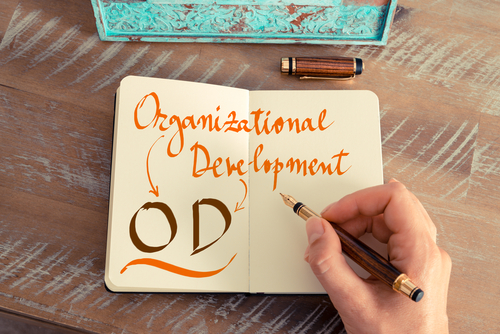
Organizations such as businesses and foundations are somewhat like living organisms. Just as living creatures have respiratory systems, digestive systems and reproductive systems, organizations have management, supply chains, employee development and other aspects of successful function. Like living creatures, organizations must adapt to changing environments to work well. Sometimes this adaptation is a natural process, but usually symptoms manifest, a diagnosis is made, treatments are implemented and the condition or progress of the organization is monitored.
That process is called organizational development. It is a concept that has been around for some time, but the globalization of both the economy and culture has increased the pace at which change must occur, and also the kind of changes that are necessary.
Featured Programs
Goals of Organizational Development Interventions
All organizations exist to reach certain goals. That may be competitiveness in the market, realizing an employee-friendly workplace or even increasing fundraiser effectiveness. The goal of organizational development is to help organizations meet their goals. In terms of business, these goals could be improving how the business performs financially, increasing consumer and/or employee satisfaction, building better engagement of the employees, management and stakeholders or simply adapting to global market requirements.
The outcome of interventions is hopefully the identification and promotion of unique resources, competencies, products and cultures that will help organizations stand out and maximize their strategies.
Organizational development interventions stem from the study of organizational development itself. In basic terms, org development interventions are structured actions or activities that are designed to improve an overall organizational system or task performance. Broadly speaking, there are three primary elements of a comprehensive intervention process:
- Assess information
- Process new strategies
- Integrate new approaches
Beyond this trio of primary elements, there are eight steps associated with the intervention process.
The Eight Steps for Organizational Development Intervention

There are eight steps at the heart of reaching the objectives of org development intervention, according to the Houston Chronicle. These steps are:
- Entry Signals
- Purpose
- Assessment
- Action Plan
- Intervention
- Evaluation
- Adoption
- Separation
Entry Signals
In many ways, what are known as early signals are precursors with the organizational development intervention process itself. Early signals refer to the flags that an organizational leader sees, both inside and outside of the organization itself. These flags or early signals cause organizational leaders to start contemplating the necessity for change. An external flag could be witnessing a competitor developing some sort of innovative solution. An internal one could be an influx of negative feedback on the services or products of a business.
Purpose
At the purpose step, the core issues are identified and defined. At this stage, an outside change agent may be brought on board to oversee the organizational development intervention process itself. A third-party change agent typically investigates issues and gathers information. The objective is to develop a purposeful strategy to make changes through the intervention process.
Assessment
During the assessment phase of the intervention process, data previously gathered is summarized and presented to the organization’s key stakeholders. In this way, stakeholders are aware of the issues and have ownership when it comes to the comprehensive intervention process itself.
Action Plan
At the conclusion of the assessment stage, management, other leaders, and stakeholders develop an action plan to address identified problems or issues. The action plan sets include everything from the establishment of milestones to identifying specific team members who will undertake certain roles and tasks.
Intervention
The intervention step itself is when the implementation of recommendations in the action plan commences. The entire team is included in the intervention process. This includes educated themselves fully on the action plan. In addition, discussions are had about how the action plan can be implemented with the least amount of disruption to the organization’s operation.
Evaluation
Once organizational development interventions are completed, leadership evaluates the results of the process. Different metrics are collected and assessed. This includes a correlating these metrics with the initial action plan.
Adoption
After the evaluation is completed a determination is made by the organization as to whether the changes that arose during the intervention will be a new and permanent part of the organization’s policy.
Separation
Separation occurs when policies and changes derived from the intervention process are implemented. In addition, this is the phase when any third-party agent departs.
Types of Intervention
All the steps of intervention are the result of scientific theories and evidence. They are established protocols and not just (as the cliché says) “run-it-up-the-flagpole-and-see-who-salutes” solutions. As such, there are different types of interventions to meet the needs of different problems within the organization.
Human Process Interventions
These are interventions targeting interpersonal relationships and the dynamics of group performance.
On an individual basis, they can be used to change the way an individual such as a manager communicates with employees or even the way employees communicate with one another. They can be used to alter unproductive behaviors, to create productive habits and to increase overall self esteem.
Group interventions look at the way groups are formed and how they function to achieve their goals. Interventions may include things like team building skills to change the dynamics within a group or evaluate and address intergroup communication. These interventions may also target large groups such as one consisting of management, employees and stakeholders.
Sometimes, as noted above, a third party might be brought in to consult. One reason this might occur is the development of an “observer bias.” Simply put, that refers to the tendency most people have to see what they expect to see. Consultants bring a fresh view to the situation and also fresh methodology. Another reason for importing a consultant is to resolve conflicts. Many times conflict is a positive factor because it can fuel discussion and lead to solutions. It can also, however, result in stalemates where no progress is made at all. Consultants with no stake in the discussion can bring reason to the issue.
Technology and Structural Interventions

These are interventions built upon the successful implementation of technology into organizational systems. That, of course, entails not only analyzing which technologies should be brought on board, but making certain employees have the competencies to use them. The interventions also address problems in organizational design. That is, the structure of function in the organization and whether it is effective in enabling the organization to adapt to change. For instance, one design organizations follow is the central authority model. This assumes one person or small group of people in management make all decisions autonomously. There is rigid control and employees have little or no input. Another model, decentralized management, allows employees and others to have a voice in decision making. Employees interact with customers and clients and have a stake in company success. Additionally, in this model, there are incentives for innovation and improvement.
This intervention assesses quality management and looks at whether organizations make rapid adjustments to meet demands or whether they are continuously making changes as part of the company culture. It also attempts to increase productivity while making jobs more interesting and challenging to improve the quality of life for employees.
HR Interventions
While organizational development is not the same thing as a human resource department, the two do work together. Issues may be identified within an organization with regard to “talent development,” performance management, child care and even diversity that require the development of an intervention strategy using the HR department.
Diversity is a major cultural, and so industrial, topic today. Things such as gender, sexual identification, age, race, disabilities and even culture enter the business arena and impact the ability of organizations to meet their goals.
Another intervention is in the area of employee wellness. This involves promoting active lifestyles and stress management among other health issues for employees and other organization members.
All of these interventions may be seen through one of three lenses. They can affect transformational change, which means the organization is completely “rewired.” They can also be continuous change in which gradual transformation and adaptation are woven into the fabric of the organization through policies and culture. The last lens is trans organizational change in which adaptations occur through mergers, acquisitions or networking.
Difficulties of Organizational Development Interventions

Change, for the better or worse, is always difficult. That is because it is not a passive issue. It requires work. An article in the Harvard Business Review says there is also an attitude in the business culture that most attempts to create organizational change fail. This myth comes from a book written in 1993 called Reengineering the Corporation. In that book, authors Michael Hammer and James Champy make the assertion that 50-to-70 percent of organizations that attempt change fail. They included the disclaimer that the statistics were an “unscientific estimate.” The damage had been done, however, and the statistics were repeated again and again as fact. The 50 percent was dropped and the remaining suggestion was that 70 percent of business transformations are doomed to fail. So, one prevailing factor in the failure of organizational development procedures is the assumption that they won’t work anyway.
A recent study found that 1/3 of managers who had attempted change initiatives in their companies said that the interventions were a total success. Another third said the project was mostly successful. The remaining third replied that their initiatives were only partially successful or failed completely.
Necessity of Change
Probably the greatest hurdle that those wanting to affect change in business must leap is that managers and company officers don’t make the case for why it is necessary. They simply announce unilaterally that change will happen. Plus, they make that announcement in language that is full of statistics and facts to which others may not relate. For lasting change to occur, however, everybody must buy into the concept. That means there has to be “something to sweeten the pot” for all players. The use of fear is a common, but not really effective motivator. The best incentive for people to want change to see how that change will make life better for them, for instance building their careers and creating a better work environment.
Lack of Resources
Another difficulty is that organizations lack the resources to implement change. The management assumes that change will be immediate ( which it won’t) and that it won’t be a costly endeavor ( which it will). Change is a long-term process that requires that interventions be tried, tested, tweaked and reapplied many times. That costs money and takes time that many organizations just don’t have.
Lack of Planning
Sometimes failure comes because of lack of planning. The people instituting the change are so focused on getting it accomplished that they do not spend the necessary time in identifying issues, designing interventions, setting goals and creating timelines. There is no foundation built upon which the interventions may rest, and so the project crumbles.
System Investment Instead of People Investment
Although implementing new systems or technology may be a big part of an intervention, managers sometimes forget that there are people issues as well. Employees must be trained and supported in their utilization of the technology.
Weak Leadership
Affecting change, from recognizing problems, identifying the issues, designing interventions and implementing them and assessing their success are all things that require strong leadership skills. Often called “soft skills,” the ability to communicate and work with individuals and groups of people as well as motivate and inspire cooperation are vital tools to a leader. Strong leaders are visionaries who can translate dreams into actions.
Who are Organizational Development Intervention Specialists
Although change and adaptation may be instituted in an organization by its leadership, that leadership must have the knowledge and skills to drive it. When a third-party consultant is brought in, who is that individual or group? The Bureau of Labor Statistics lists organizational development consultants as “training and development managers.” The projected job growth for the field is seven percent, which is faster than average. Consultants can enter the field with an undergraduate degree and work experience, but supervisory or independent consultant work requires a master’s degree in psychology, business administration or a like field with concentrations in organizational development, human resources management or other related areas.
Many of these professionals also acquire certifications through associations such as The International Society for Performance Improvement, The Association for Talent Development and the Society for Human Resource Management.
The median salary for a training and development manager is $113,350.
Because of the overall success of this type of process, organizational development interventions are likely to continue to be fairly widely utilized.
Related Resources: